Numerical Assessment of the Influences of Gas Pressure on Coal Burst Liability
Abstract
:1. Introduction
2. Empirical Study of Gas Pressure Effects on Coal Burst Liability
2.1. Mechanism of Gas Pressure Effect on Coal Burst Liability
2.2. Selection of Coal Bursting Liability Indices of Coal Pillar
3. Numerical Model and Determination of Parameters
3.1. Numerical Model and Failure Criterion
3.2. Boundary Conditions of Numerical Model
3.3. Determination of Pillar Parameters
3.4. Determination of Gas Parameter
4. Results of the Numerical Analysis
4.1. Complete Stress-Strain Curve of Coal Pillar
4.2. Relationship between Gas Pressure and Bursting Energy Index
5. Discussion
5.1. Deformation Detail of the Coal Pillar
5.2. The Relationship between Gas Pressure and Coal Pillar Bursting Liability
6. Conclusions
- The complete stress-strain curve of the coal pillar during loading can be derived from the numerical simulation results. Based on the derived stress-strain curve, the peak point of the failure envelope can be determined and used to calculate the area under the curve of the pre- and post-failure response.
- The area under the curve of the pre- and post-failure response represent the sum of elastic strain and plastic strain energy before the failure, and the dissipated energy after the failure, respectively. The BEI is then applied to determine the coal pillar bursting liability by applying the pre- and post-failure energy principle.
- From the analysis of the stress-strain curves obtained from the numerical simulation, it was observed that before the gas pressure within the pillar reaches a magnitude of 50 kPa, there is a positive non-linear relationship between gas pressure and the BEI. In other words, doubling the gas pressure does not necessarily result in a two-fold increase in the likelihood of the bursting potential for a particular coal pillar.
- Analyses of loaded coal pillar stress-strain curves, BEI values, and the displacements of pillars, indicate that when the gas pressure exceeds a threshold of greater than 50 kPa, the BEI growth rate will decrease at a rate that is dependent on the size of the coal pillar.
- Finally, stress-strain curves and BEI values also show a marked difference in deformation patterns beyond a 50 kPa gas pressure threshold. The deviation is due to changes in loading conditions and stress states resulting in quasi-failed coal pillars, as a result of the high gas pressure. Further studies are warranted to validate the observed deviation in BEI trends and coal pillar failure modes beyond gas pressure thresholds of 50 kPa.
Acknowledgments
Author Contributions
Conflicts of Interest
References
- Dou, L.M.; Lu, C.P.; Mu, Z.L.; Gao, M.S. Prevention and forecasting of rock burst hazards in coal mines. Min. Sci. Technol. 2009, 19, 585–591. [Google Scholar] [CrossRef]
- Jiang, Y.D.; Zhao, Y.X. State of the art: Investigation mechanism, forecast and control of coal bumps in China. Chin. J. Rock Mech. Eng. 2015, 34, 2188–2204. [Google Scholar]
- Liu, J.; Wang, E.Y.; Song, D.Z.; Wang, S.H.; Niu, Y. Effect of rock strength on failure mode and mechanical behavior of composite samples. Arab. J. Geosci. 2015, 8, 4527–4539. [Google Scholar] [CrossRef]
- Guo, W.; Zhao, T.; Tan, Y.; Yu, F.; Hu, S.; Yang, F. Progressive mitigation method of rock bursts under complicated geological conditions. Int. J. Rock Mech. Min. Sci. 2017, 96, 11–22. [Google Scholar] [CrossRef]
- Jiang, Y.D.; Zhao, Y.X.; He, M.C.; Peng, S.P. Investigation on mechanism of coal mine bumps based on mesoscopic experiments. Chin. J. Rock Mech. Eng. 2007, 26, 901–907. [Google Scholar]
- Mallikarjun, P.; Satya, H.; Liu, S.M. Gas diffusion behavior of coal and its impact on production from coalbed methane reservoirs. Int. J. Coal Geol. 2011, 86, 342–348. [Google Scholar]
- Wang, Z.; Yin, G.Z.; Hu, Q.T.; Jin, H.W. Inducing and transforming conditions from rockburst to coal-gas outburst in a high gassy coal seam. J. Min. Saf. Eng. 2010, 27, 572–575. [Google Scholar]
- Shen, B.; King, A.; Guo, H. Displacement, stress and seismicity in roadway roofs during mining-induced failure. Int. J. Rock Mech. Min. Sci. 2008, 45, 672–688. [Google Scholar] [CrossRef]
- Tulu, I.B.; Esterhuizen, G.S.; Klemetti, T.; Murphy, M.M.; Sumner, J.; Sloan, M. A case study of multi-seam coal mine entry stability analysis with strength reduction method. Int. J. Min. Sci. Technol. 2015, 26, 193–198. [Google Scholar] [CrossRef] [PubMed]
- Wang, Z.; Hu, Q.T.; Yin, G.Z. Experimental research on the burst proneness index of coal threated with gas pressure. J. China Univ. Min. Technol. 2010, 39, 516–519. [Google Scholar]
- Wen, Z.J.; Tan, Y.L.; Han, Z.Z.; Meng, F.B. Construction of time-space structure model of deep stope and stability analysis. Pol. J. Environ. Stud. 2016, 25, 2633–2639. [Google Scholar] [CrossRef]
- Liu, X.; Wang, X.; Wang, E.; Kong, X.; Zhang, C.; Liu, S.; Zhao, E. Effects of gas pressure on bursting liability of coal under uniaxial conditions. J. Nat. Gas Sci. Eng. 2017, 39, 90–100. [Google Scholar] [CrossRef]
- Su, C.D.; Yuan, R.F.; Zhai, X.X. Experimental research bursting liability index of coal samples of Chengjiao coal mine. Chin. J. Rock Mech. Eng. 2013, 32 (Suppl. 2), 3692–3704. [Google Scholar]
- Khair, A.W. An analysis of coal bump liability in a bump prone mine. Int. J. Min. Eng. 1985, 3, 243–259. [Google Scholar] [CrossRef]
- Kidybinski, A. Bursting liability indices of coal. Int. J. Rock Mech. Min. Sci. Geomech. Abstr. 1981, 18, 295–304. [Google Scholar] [CrossRef]
- Pan, J.F.; Ning, Y.; Du, T.T.; Lan, H.; Zhang, Y.; Liu, J.; Xia, Y.X.; Wei, Z.X. The theory and system for preventing rock burst in large-scale areas. J. China Coal Soc. 2012, 37, 1803–1809. [Google Scholar]
- Qi, Q.X.; Peng, Y.W.; Li, Y.H.; Li, J.Q.; Wang, Y.G.; Li, C.R. Study of bursting liability of coal and rock. Chin. J. Rock Mech. Eng. 2011, 30 (Suppl. 1), 2736–2742. [Google Scholar]
- Wu, Y.; Zhang, W. Evaluation of the bursting proneness of coal by means of its failure duration. In Rockbursts and Seismicity in Mines; Gibowicz, S.J., Lasocki, S., Eds.; A. A. Balkema: Rotterdam, The Netherlands, 1997; pp. 285–288. [Google Scholar]
- Zhao, Y.X.; Jiang, Y.D. Acoustic emission and thermal infrared precursors associated with bump-prone coal failure. Int. J. Coal Geol. 2010, 83, 11–20. [Google Scholar] [CrossRef]
- Zhang, C.; Canbulat, I.; Bruce, H.; Ward, C.R. Assessing coal burst phenomena in mining and insights into directions for future research. Int. J. Coal Geol. 2017, 179, 28–44. [Google Scholar] [CrossRef]
- Liu, Q.; Cheng, Y.; Wang, H.; Kong, S.; Dong, J.; Chen, M.; Zhang, H. Numerical assessment of the influences of coal permeability and gas pressure inhomogeneous distributions on gas drainage optimization. J. Nat. Gas Sci. Eng. 2017, 45, 797–811. [Google Scholar] [CrossRef]
- Li, Z.; Nocelli, B.; Saydam, S. Effect of rock strength and surface roughness on adhesion strength of thin spray-on liners. Int. J. Rock Mech. Min. Sci. 2017, 91, 195–202. [Google Scholar] [CrossRef]
- Cook, N.G.W. The seismic location of rockbursts. In Proceedings of 5th U.S. National Symposium on Rock Mechanics; Pergamon Press: Oxford, UK, 1963; pp. 493–516. [Google Scholar]
- Neyman, B.Z.; Szecowka, Z.; Zuberek, W. Effective methods for fighting rockbursts in polish collieries. In Proceedings of the 5th International Strata Control Conference, London, UK, 21 August 1972; p. 23. [Google Scholar]
- Petukhov, I.M.; Linkov, A.M. The theory of post-failure deformations and the problem of stability in rock mechanics. Int. J. Rock Mech. Min. Sci. Geomech. Abstr. 1979, 16, 57–76. [Google Scholar] [CrossRef]
- Salamon, M.D.G.; Wagner, H. The Role of Stabilising Pillars in the Alleviation of Rockburst Hazzard in Deep Mines; Research Report No. 27/79; Chamber of Mines of South Africa Research Organization: Johannesburg, South Africa, 1979. [Google Scholar]
- Lan, H.; Pan, J.; Peng, Y. Numerical simulation for energy mechanism of underground dynamic disaster. Meitan Xuebao/J. China Coal Soc. 2010, 35, 10–14. [Google Scholar]
- Li, C.; Xie, B.; Cao, J.; Wang, T.; Wang, X. The energy evaluation model of coal and gas outburst intensity. Meitan Xuebao/J. China Coal Soc. 2012, 37, 1547–1552. [Google Scholar]
- Classification and Laboratory Test Method on Bursting Liability of Coal; GT/T 25217. 2-2010; Standards Press of China: Beijing, China, 2010.
- Jiang, Y.D.; Wang, H.W.; Zhao, Y.X.; Zhu, J.; Pang, X.F. The influence of road way backfill on bursting liability and strength of coal pillar by numerical investigation. Procedia Eng. 2011, 26, 1125–1143. [Google Scholar]
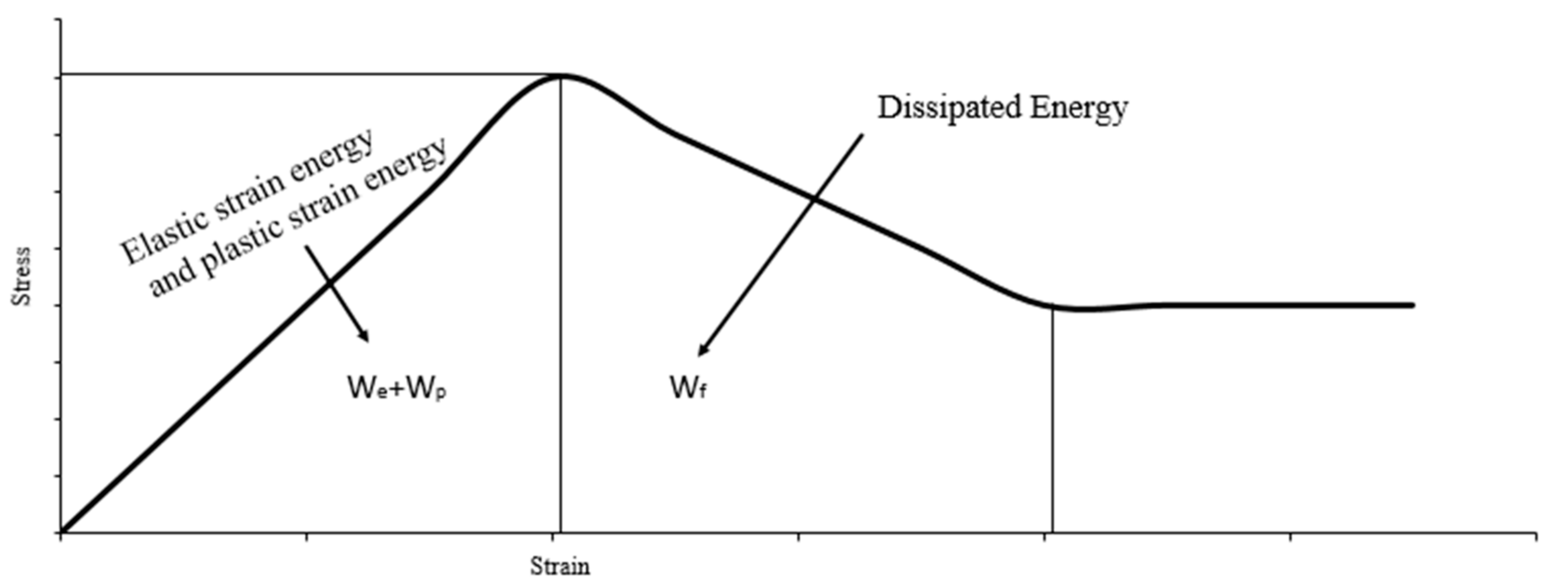
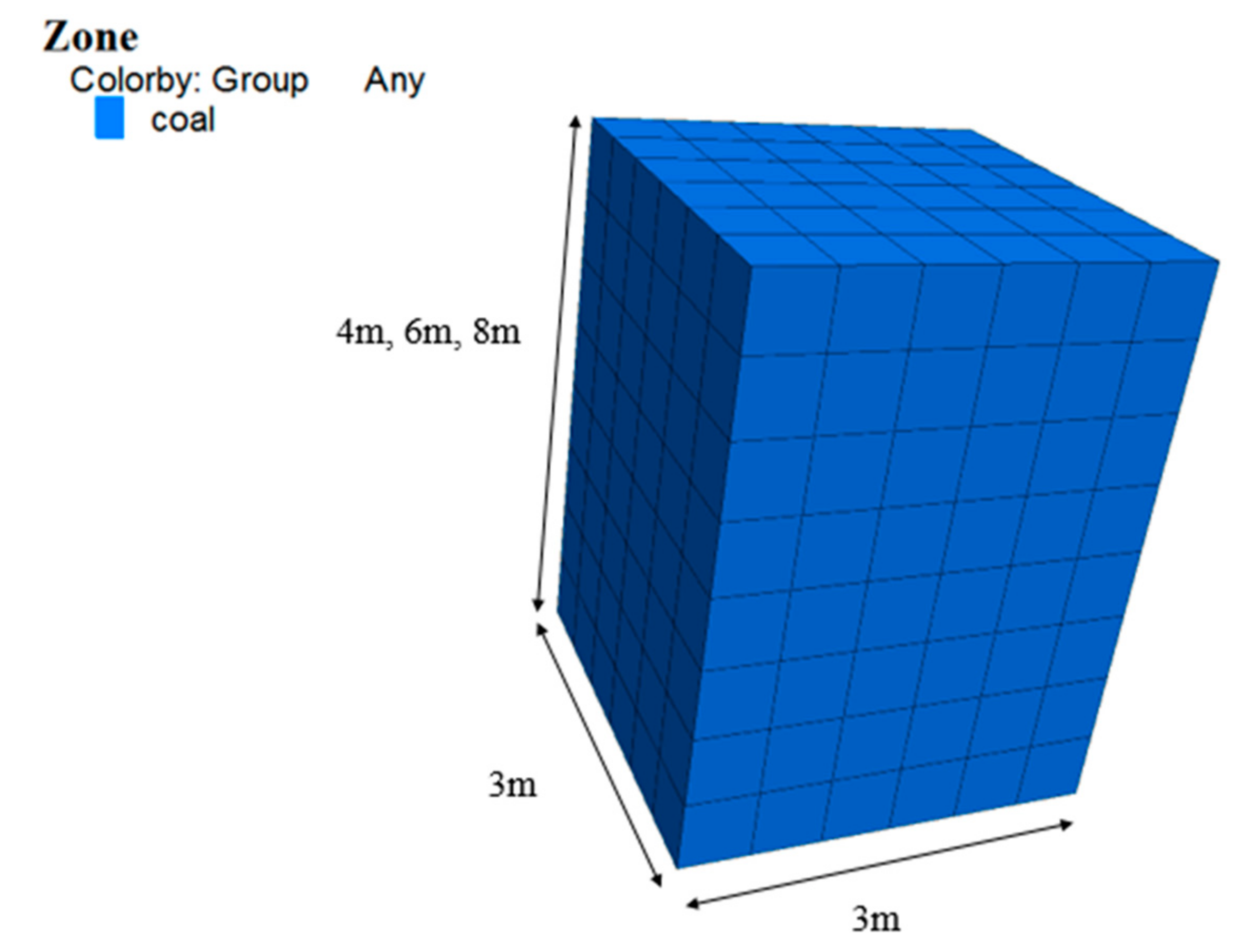
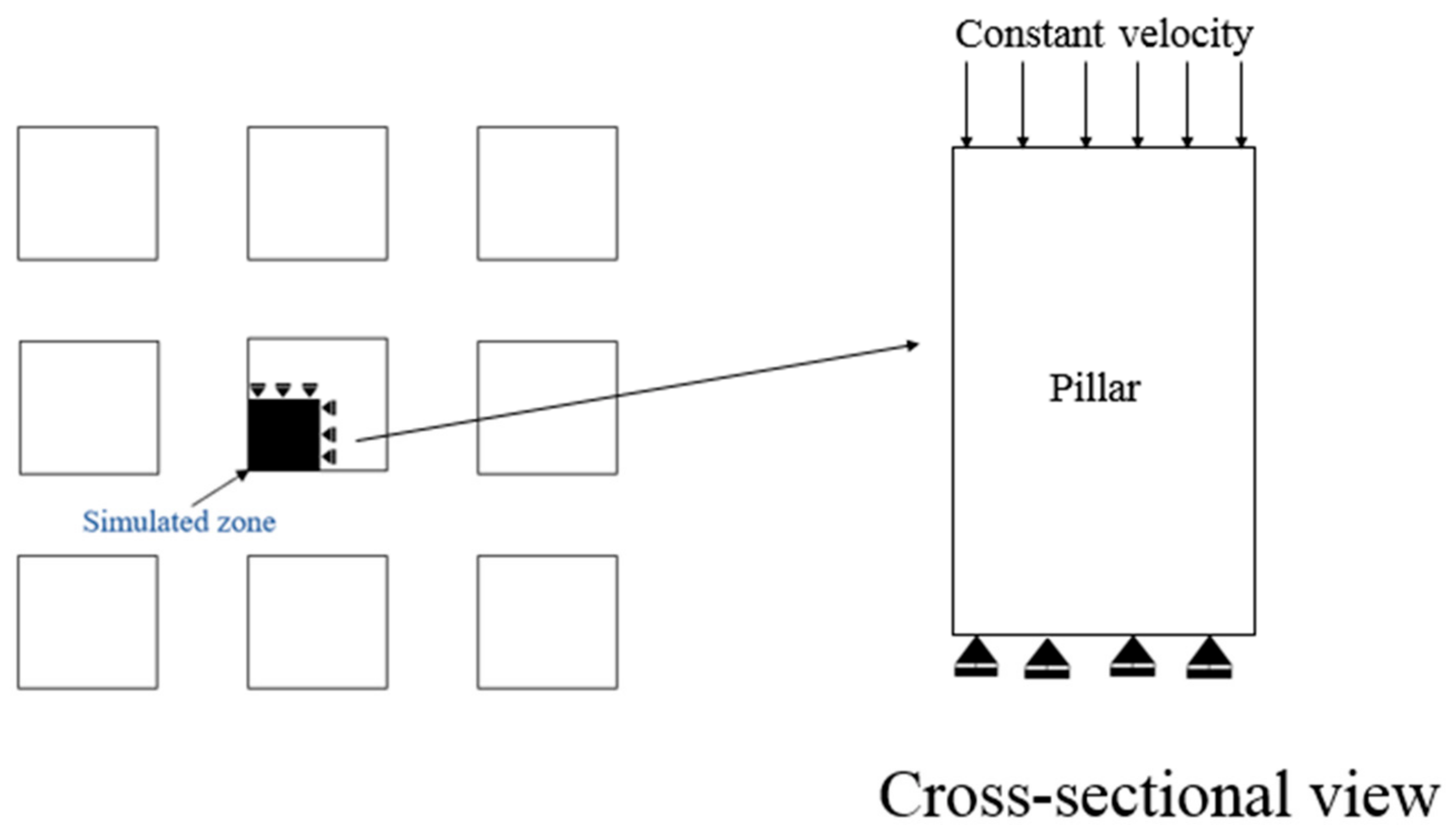
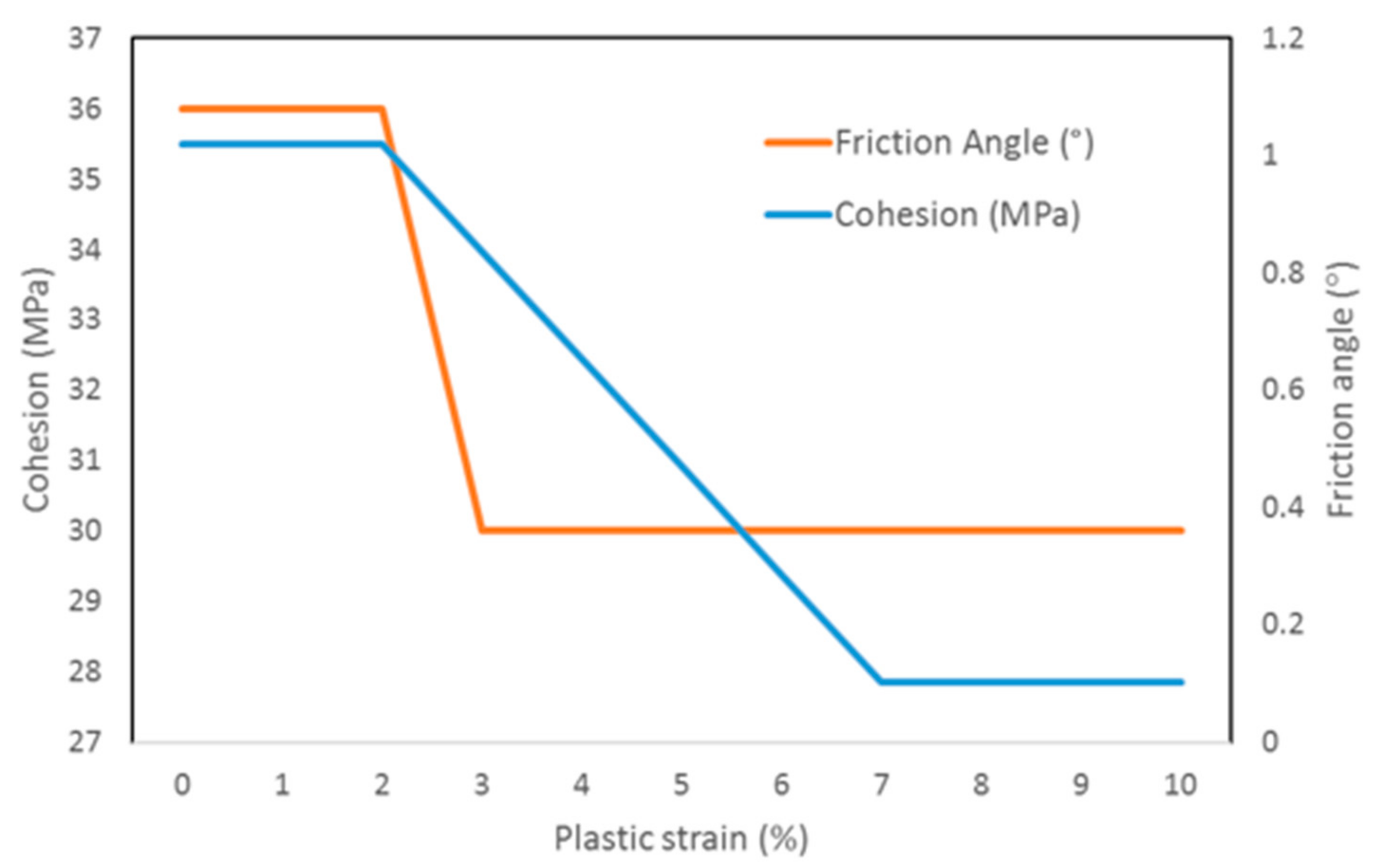

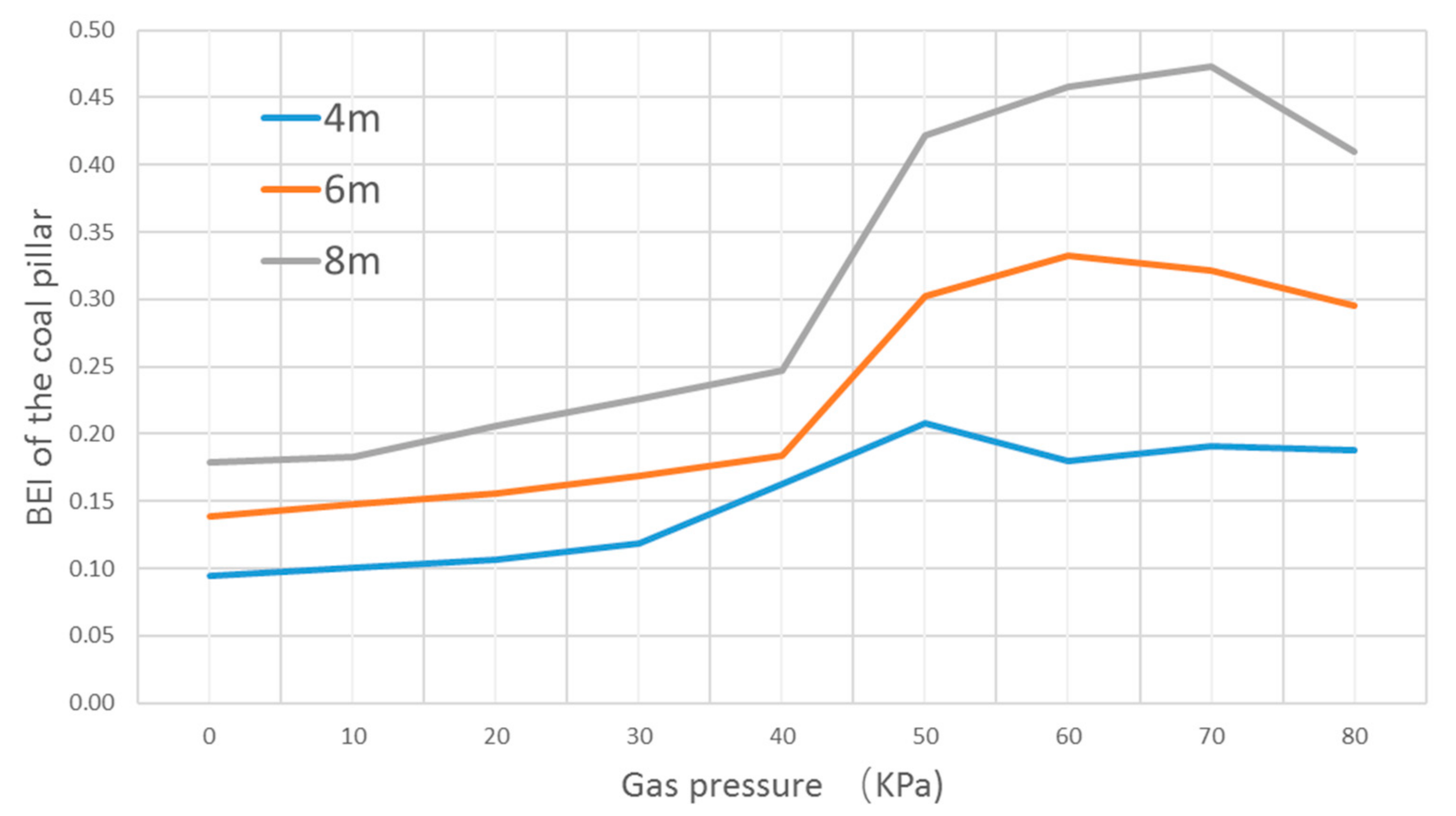
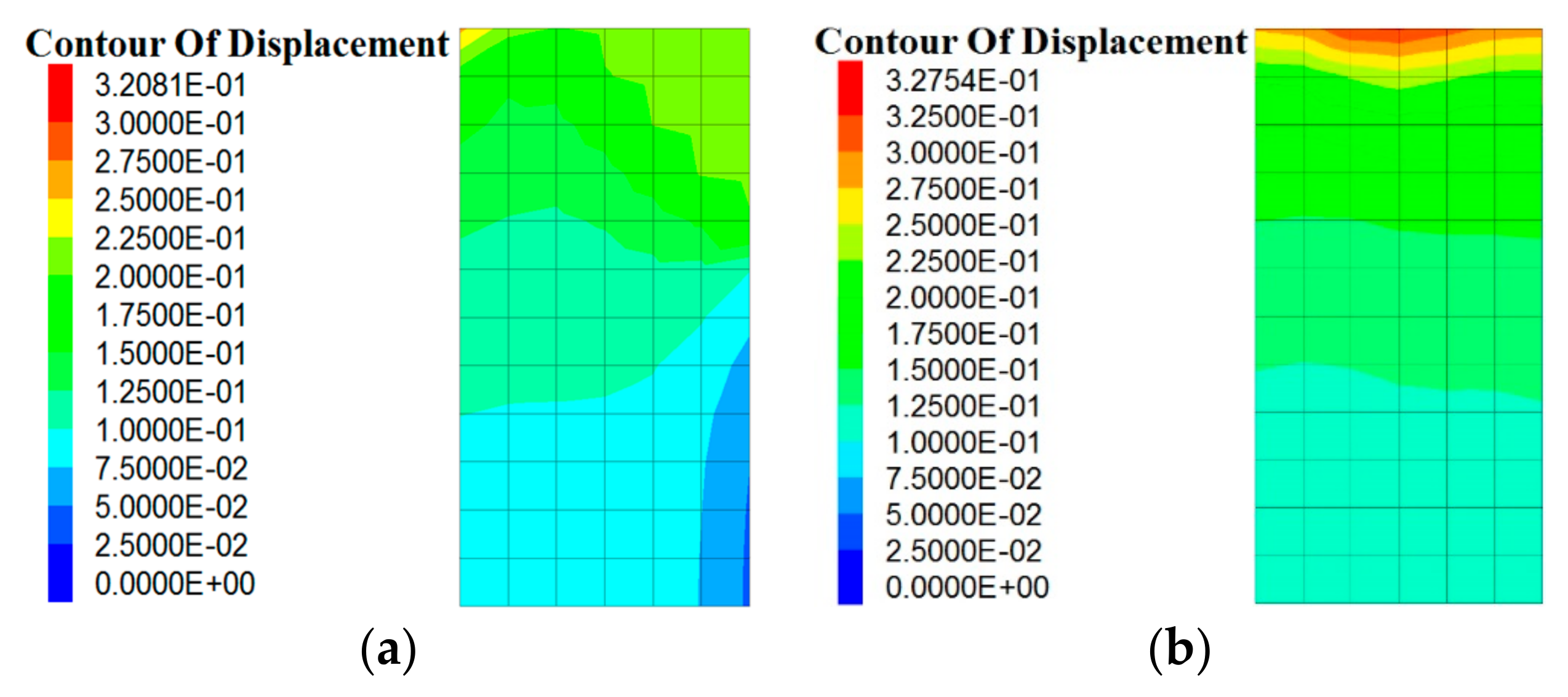

| Property | Young’s Modulus (GPa) | Poisson’s Ratio | UCS (MPa) | Tensile Strength (MPa) | Cohesion | Friction Angle | Dilation Angle (°) | ||||
|---|---|---|---|---|---|---|---|---|---|---|---|
| Original Value (MPa) | Softening Rate (%) | Residual Value (MPa) | Original Value (°) | Softening Rate (%) | Residual Value (°) | ||||||
| Coal | 1.1 | 0.3 | 4.0 | 0.04 | 1.02 | 5.0 | 0.102 | 36. | 0.5 | 30 | 6.000 |
| Porosity | Coefficient of Permeability (m2) | Gas Pressure (MPa) | Gas Density (kg/m3) | Gas Bulk Modulus (GPa) | Tensile Strength (MPa) |
|---|---|---|---|---|---|
| 0.05 | 2.5 × 10−17 | 0.6 | 0.716 | 0.254 | 0 |
| Approximate Gas Pressure (kPa) | WCF of the Coal Pillar | ||
|---|---|---|---|
| Pillar Width | |||
| 4 m | 6 m | 8 m | |
| 0 | 0.094241 | 0.139070 | 0.178855 |
| 10 | 0.100948 | 0.147380 | 0.183257 |
| 20 | 0.106179 | 0.155855 | 0.205874 |
| 30 | 0.118474 | 0.168808 | 0.225705 |
| 40 | 0.162327 | 0.183565 | 0.246674 |
| 50 | 0.207636 | 0.302613 | 0.421820 |
| 55 | 0.203702 | 0.314283 | 0.390673 |
| 57 | 0.197033 | 0.304107 | 0.429803 |
| 60 | 0.179775 | 0.332554 | 0.458227 |
| 63 | 0.202187 | 0.313859 | 0.456203 |
| 65 | 0.196584 | 0.303701 | 0.469571 |
| 70 | 0.191153 | 0.321037 | 0.473001 |
| 80 | 0.187907 | 0.294913 | 0.409714 |
© 2018 by the authors. Licensee MDPI, Basel, Switzerland. This article is an open access article distributed under the terms and conditions of the Creative Commons Attribution (CC BY) license (http://creativecommons.org/licenses/by/4.0/).
Share and Cite
Zhao, H.; Kaunda, R.B. Numerical Assessment of the Influences of Gas Pressure on Coal Burst Liability. Energies 2018, 11, 260. https://doi.org/10.3390/en11020260
Zhao H, Kaunda RB. Numerical Assessment of the Influences of Gas Pressure on Coal Burst Liability. Energies. 2018; 11(2):260. https://doi.org/10.3390/en11020260
Chicago/Turabian StyleZhao, Haochen, and Rennie B. Kaunda. 2018. "Numerical Assessment of the Influences of Gas Pressure on Coal Burst Liability" Energies 11, no. 2: 260. https://doi.org/10.3390/en11020260




